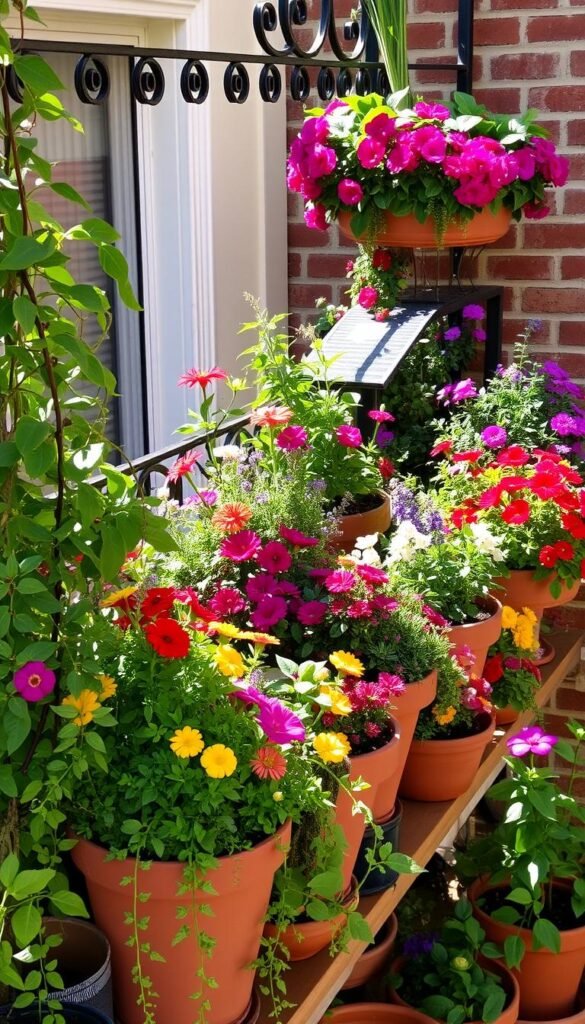Transforming your compact outdoor area into a vibrant green retreat might seem challenging, but it’s surprisingly achievable with thoughtful planning. Whether you’re working with a narrow ledge or a cozy corner, container gardening opens doors to creativity while respecting spatial limits. You’ll find that even the tiniest spots can burst with life when approached strategically.
Urban dwellers are increasingly turning to their balconies as spaces to reconnect with nature. By using vertical planters, multi-tiered stands, and imaginative containers like repurposed crates, you can maximize every inch. This method isn’t just practical—it lets you experiment with seasonal blooms and foliage combinations that reflect your personality.
Success starts with understanding your environment. Shady areas might host witch hazel or ferns, while sun-drenched spots could showcase milkweed or coneflowers. As highlighted in this guide to native plants that thrive in containers, selecting species adapted to your conditions ensures healthier growth and less maintenance.
The joy of balcony gardening lies in its flexibility. You’re not just arranging plants—you’re crafting a living sanctuary that evolves with your tastes. With smart design choices and a dash of inspiration, your elevated oasis will become a daily source of pride and calm.
Getting Started with Your Urban Balcony Garden
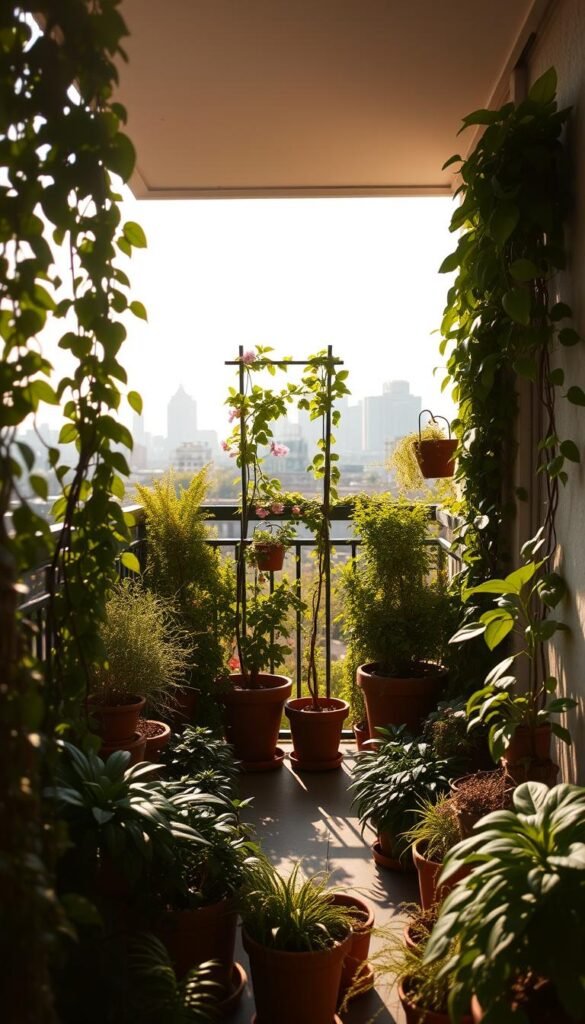
Your balcony holds hidden potential—unlock it by first understanding its limits. Begin by measuring floor space and noting where hanging displays could thrive. This step ensures you don’t overcrowd your area while leaving room for movement.
Check your building’s rules about weight limits and outdoor modifications. Many complexes restrict heavy planters or wall-mounted systems. Knowing these guidelines upfront saves time and prevents costly mistakes.
Next, study your balcony’s microclimate. Track sunlight patterns for 2-3 days—note which spots get full sun versus shade. Wind exposure matters too: corners near railings often face stronger gusts that can dry out plants quickly.
Match your greenery to these conditions. Sheltered areas work for delicate herbs, while sturdy succulents thrive in sunny, windy zones. Use lightweight containers in high-wind locations to prevent accidents.
Sketch a rough layout prioritizing accessibility. Leave pathways wide enough for watering cans and pruning tools. Tiered stands near walls maximize vertical space without blocking views. Remember: a functional design beats a cluttered one every time.
Potted Flower Garden for Small Spaces: Balcony-Friendly Arrangements
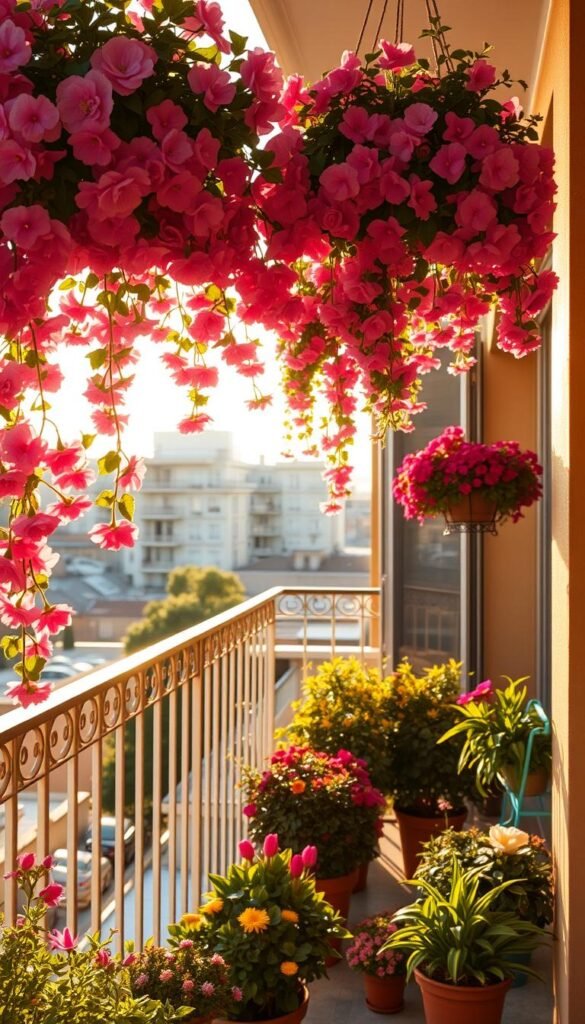
Designing vibrant container displays begins with spatial awareness. Start by grouping potted plants in odd numbers—three or five per cluster—to create natural rhythm. Mix tall grasses with trailing vines and mid-height flowers for instant depth. This approach tricks the eye into perceiving more space than actually exists.
Another trick? Layer containers vertically using risers or stacked crates. Place moisture-loving species at the bottom and drought-tolerant varieties higher up. This not only saves floor space but also simplifies watering routines. Pair silver-leaved sage with purple petunias for striking contrast that pops against railings.
When planning your balcony setup, prioritize plants with matching needs. A sun-loving succulent trio (like sedum, echeveria, and aeonium) thrives together with minimal care. For shady corners, combine ferns with coral bells and creeping Jenny. These combinations ensure all plants flourish under identical conditions.
Wind-resistant arrangements prove essential for elevated spaces. Opt for sturdy options like lantana or dwarf hydrangeas in heavy ceramic pots. Rotate containers weekly to promote even growth and prevent legginess. With these strategies, your urban green space becomes a dynamic living canvas that evolves seasonally.
Choosing the Ideal Containers and Pots
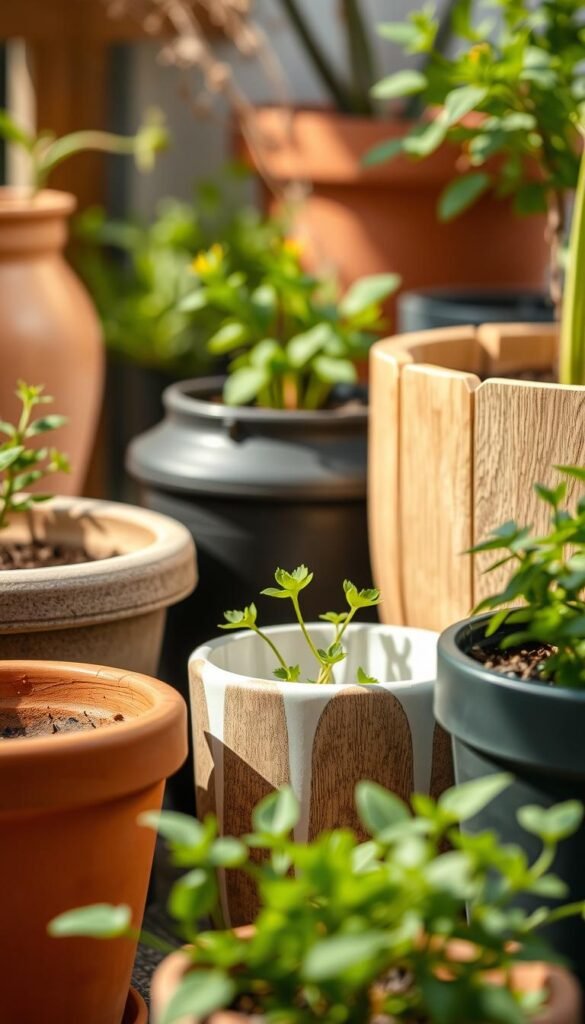
Selecting containers is more than just picking pretty pots—it’s about matching materials to your balcony’s unique needs. Your choices impact everything from plant health to how easily you can rearrange your green space. Let’s break down the options to help you make smart decisions.
Exploring Plastic, Ceramic, and Fiberglass Options
Lightweight plastic pots shine in weight-restricted areas. They’re easy to move and won’t crack in freezing temps. But they might tip over in strong winds—anchor them with decorative rocks at the base.
Ceramic containers add elegance but demand careful placement. Their heft stabilizes tall plants, yet they’re fragile in extreme weather. Fiberglass strikes a balance: durable like ceramic but half the weight. Perfect for creating focal points without straining railings.
| Material | Weight | Durability | Best For |
|---|---|---|---|
| Plastic | Light | 3-5 years | Herbs & annuals |
| Ceramic | Heavy | 5+ years | Small trees |
| Fiberglass | Medium | 7+ years | Focal plants |
Utilizing Hanging Baskets and Tiered Planters
Hanging baskets unlock overhead space—try trailing lobelia or strawberries in rail-mounted designs. Tiered planters let you grow upwards: place shade-lovers on lower shelves and sun-seekers above.
Fabric grow bags offer portability for renters. Their breathable walls prevent root rot in moisture-sensitive plants. Pair them with collapsible stands for instant vertical gardens that pack flat when moving.
Remember: mix materials for visual interest. A ceramic pot anchoring a tiered system creates depth, while plastic baskets add pops of color at eye level. Your balcony’s personality starts with the containers you choose!
Selecting the Perfect Plants and Flowers
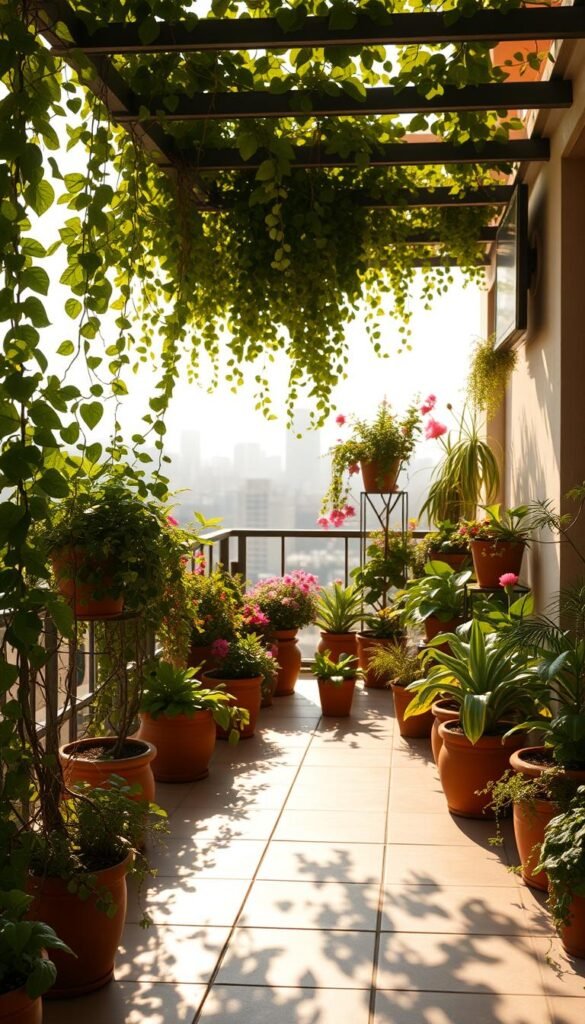
Your balcony’s success as a green retreat starts with smart plant pairings. Matching species to your light conditions creates thriving displays that demand less upkeep. Let’s explore how to build lush combinations tailored to your unique space.
Sun-Loving Varieties vs. Shade-Tolerant Choices
Bright balconies need sun-worshipping plants that handle heat. Petunias explode with color in full light, while geraniums offer drought-resistant blooms. Marigolds add fiery orange hues and naturally repel pests—perfect for edible gardens.
Shady corners come alive with texture-rich options. Begonias deliver months of pink or white flowers under filtered light. Pair them with fuchsias’ dangling blooms for vertical interest. Hostas and coleus work well too, offering striking foliage patterns.
| Light Needs | Top Picks | Care Tip |
|---|---|---|
| Full Sun | Lantana, Zinnias | Water deeply 3x weekly |
| Partial Shade | Impatiens, Ferns | Mulch to retain moisture |
Herbs and Fragrant Blooms for Your Space
Elevate your balcony with scented herbs that multitask. Basil and thyme thrive in sunny spots, doubling as kitchen staples. Lavender’s purple spikes attract pollinators while calming evening breezes.
For fragrance-focused displays, mix jasmine vines with gardenias. Their intoxicating scents intensify at night. Position these near seating areas to create sensory retreats. Remember to group plants with matching water needs—succulents shouldn’t share pots with moisture-loving mint.
Combine edible and ornamental species using practical container strategies. Dwarf citrus trees add structure beneath trailing nasturtiums. This approach maximizes yield and beauty in tight quarters.
Understanding Watering and Maintenance Needs
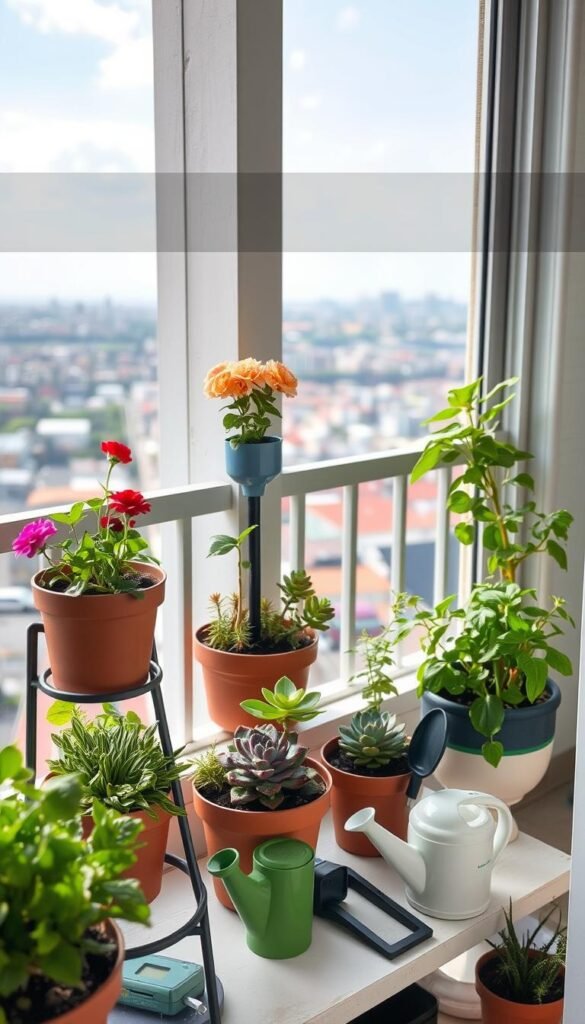
Keeping your elevated garden thriving starts with smart hydration strategies. Balcony plants face unique challenges—wind steals moisture, while limited soil space demands precise watering. Let’s explore how to meet these needs without turning your routine into a chore.
Effective Watering Techniques for Small Spaces
Check soil moisture daily by sticking your finger 1-2 inches deep. If it feels dry, it’s time to hydrate. Morning watering reduces evaporation, giving roots time to drink before afternoon heat hits.
Use saucers under pots to catch runoff. This prevents messes and lets plants reabsorb excess water. For windy spots, add pebbles to saucers—they stabilize containers and slow evaporation.
| Tool | Best Use | Capacity |
|---|---|---|
| Long-spout can | Reaching tight clusters | 1-2 gallons |
| Collapsible bucket | Transport from sink | 3-5 gallons |
| Spray nozzle | Delicate seedlings | Adjustable flow |
Self-Watering and Collapsible Solutions
Self-watering pots with reservoirs cut daily tasks by 50%. Fill them weekly, and capillary action keeps soil evenly moist. Pair these with moisture meters to avoid guesswork.
Collapsible watering cans save space when not in use. Look for models with built-in hose adapters—they let you refill directly from kitchen faucets. Expandable hoses work wonders too, stretching from sink to railings effortlessly.
Mulch with cocoa hulls or bark chips to lock in moisture. Choose drought-tolerant plants like sedum or lavender to reduce water needs naturally. Your plants will stay lush even during weekend getaways!
Maximizing Vertical Space for a Lush Garden
Elevate your greenery game by thinking upwards—vertical solutions multiply planting areas without cluttering your floor. Blank walls and railings hold untapped potential for creating lush displays that draw the eye upward. With smart systems, you can triple your growing capacity while keeping pathways clear.
Incorporating Vertical Garden Designs
Start with wall-mounted planters using rust-resistant brackets. These units let you grow herbs or strawberries in tight space while adding texture to bland surfaces. For climbing plants, install trellises secured with outdoor-grade zip ties—they support morning glories or peas without damaging walls.
Hanging baskets work wonders on overhangs. Use swivel hooks to rotate them for even sun exposure. Cover railings with wire mesh to guide ivy or clematis vertically, creating natural privacy screens.
| Vertical Type | Best Use | Installation Tip |
|---|---|---|
| Wall Planters | Herbs & succulents | Use toggle bolts for concrete |
| Trellis Systems | Climbing veggies | Anchor with 50lb weights |
| Hanging Baskets | Trailing flowers | Add drip trays |
| Railing Hooks | Compact herbs | Check load limits |
Always check your balcony’s weight limits before installing heavy systems. Lightweight fiberglass planters and fabric pockets offer flexibility for renters. Pair vertical elements with downward-growing varieties like creeping thyme to create cascading effects.
These arrangements trick the eye into perceiving depth, making cramped areas feel expansive. You’ll transform underused surfaces into dynamic vertical gardens that thrive season after season.
Balcony Garden Ideas for Full Sun and Partial Shade
Light transforms your balcony into a dynamic canvas—learn to work with what you’ve got. Urban spaces often juggle intense sunbeams and shaded corners, but these contrasts spark creative balcony garden ideas. Start by mapping light patterns: morning rays might hit your railing, while afternoon shade creeps under the overhang.
Choosing the Right Spots for Sunny and Shady Plants
Position sun-worshippers like lantana where light lingers longest—usually near railings or west-facing walls. Shade seekers like coleus thrive behind furniture or under hanging baskets. Rotate pots weekly to prevent lopsided growth in partial shade areas.
Create microclimates with clever tricks:
- Place light-colored stones around full sun plants to reflect heat
- Use tall plants as living umbrellas for delicate ferns
- Install adjustable shade cloth for afternoon protection
Mirror tiles or metallic planters amplify sunlight in dim corners. Try grouping white begonias with silver-dollar vines—their pale leaves act as natural reflectors. This strategy lets you grow rosemary or lavender even on a sunny balcony that’s partly obstructed.
Balance your layout by alternating light needs. Place a vibrant zinnia trio in bright zones, then transition to caladiums and impatiens in shadowy areas. This flow guides the eye while respecting each plant’s preferences. With these balcony garden ideas, you’ll craft a cohesive oasis that thrives in mixed conditions.
Incorporating Climbing and Hanging Plants
Turn your vertical spaces into living art with strategic greenery placement. Climbing varieties transform blank walls into vibrant tapestries, while hanging specimens soften harsh angles. These solutions let you craft privacy screens and eye-catching displays simultaneously.
Start by matching supports to your plant’s growth habits. Lightweight annuals like morning glories thrive on bamboo trellises, while heavy clematis needs metal grids. Always secure structures to walls or railings using rust-proof hardware—safety first!
Tips for Successful Climbing Plant Arrangements
| Support Type | Best For | Installation Tip |
|---|---|---|
| Expandable trellis | Annual vines | Use suction cups for glass surfaces |
| Chicken wire | Railings | Attach with zip ties every 12″ |
| Wall-mounted hooks | Hanging baskets | Check weight limits first |
Train tendrils gently using soft plant ties—never wire that cuts stems. Rotate containers weekly for balanced growth. For windy spots, choose sturdy climbers like jasmine or passionflower that grip supports tightly.
Hanging plants add movement to static spaces. Try ivy spilling from ceiling-mounted planters or ferns in cascading wall pockets. Mix textures: pair string-of-pearls’ round leaves with spider plants’ strappy foliage.
Remember: combine climbing and hanging elements for layered depth. A trellis-mounted mandevilla paired with trailing lobelia creates vertical drama. Your balcony becomes a 3D green sculpture that evolves daily!
Seasonal Planting Strategies to Encourage New Blooms
Your urban garden’s beauty doesn’t have to fade with the calendar. By syncing with nature’s rhythm, you can maintain vibrant colors from spring’s first buds to autumn’s final flourish. The secret? Strategic care that encourages new blooms while preparing for seasonal shifts.
Master deadheading to boost flowering power. Pinch spent petunia blossoms weekly, cutting just above leaf nodes. This redirects energy from seed production to fresh buds. Geraniums and marigolds respond especially well—expect 30% more flowers within weeks.
Rotate plants seasonally using this simple system:
- Spring: Pansies and snapdragons for cool-weather color
- Summer: Zinnias and verbena that thrive in heat
- Fall: Chrysanthemums and ornamental kale for frost resistance
Succession planting keeps displays lively. When summer annuals fade, replace them with autumn bloomers like asters. Stagger plantings every 3-4 weeks for continuous color waves. Pair this approach with our container gardening guide for seamless transitions.
Cold-tolerant varieties extend your season-long display. Mums withstand light frosts, while cyclamens brighten shaded corners as temperatures drop. Protect roots with mulch when nights turn chilly—your efforts will encourage new growth well beyond typical flowering periods.
Track each plant’s peak times using a simple calendar. This helps anticipate when to prune, feed, or rotate specimens. With thoughtful timing, your elevated oasis becomes a year-round celebration of nature’s cycles.
Leveraging Native Plants for Local Charm
Your elevated green space becomes a bridge to local ecosystems when you embrace region-specific flora. Native species naturally thrive in your area’s climate, requiring less water and care than exotic alternatives. They also form vital connections for urban wildlife, turning your balcony into a pitstop for pollinators.
“Even small clusters of native plants create stepping stones for migrating butterflies and nesting birds”
. By choosing local varieties, you’re not just gardening—you’re participating in conservation efforts that span entire neighborhoods.
Benefits of Integrating Native Species
Sun-drenched ledges come alive with milkweed’s orange blooms, drawing monarch butterflies to feed. Shady corners host woodland ferns that shelter beneficial insects. These plants evolved alongside local pests, making them naturally resistant to common diseases.
| Light Conditions | Plant Examples | Key Benefits |
|---|---|---|
| Full Sun | Coneflowers, Native Grasses | Drought-tolerant, butterfly magnets |
| Partial Shade | Solomon’s Seal, Wild Ginger | Low-light champions, pest-resistant |
Maintenance drops significantly with native species. Forget weekly fertilizing—these plants adapt to your soil’s natural nutrients. They also bloom in sync with local pollinators, ensuring your space buzzes with life from spring through fall.
By cultivating local species, you create habitat corridors that help urban wildlife navigate concrete jungles. Your balcony becomes a living classroom, sparking conversations about regional ecology with every blooming stem.
Practical Design Tips for Small Balcony Spaces
Crafting your perfect urban retreat starts with clever use of every available inch. Focus on multi-functional layouts that turn cramped areas into lush escapes while keeping movement effortless. Let’s explore how smart choices can elevate both style and practicality.
Maximizing Space with Smart Arrangements
Wall-mounted shelves instantly add planting zones without eating into floor space. Pair trailing ivy with upright herbs like rosemary for dynamic contrast. Rotate pots weekly to ensure all sides receive light—this prevents leggy growth and maintains compact shapes.
Take advantage of vertical real estate using hanging planters with cascading blooms. Nestle narrow tables between railings for extra surface area. Companion planting strategies work wonders here—try thyme beneath dwarf citrus trees to deter pests naturally.
Cluster plants in triangular formations for visual flow. Use lightweight fiberglass pots in corners to create depth without bulk. Your balcony becomes a living puzzle where every piece serves a purpose—and the result? A personalized oasis that feels twice its actual size.

